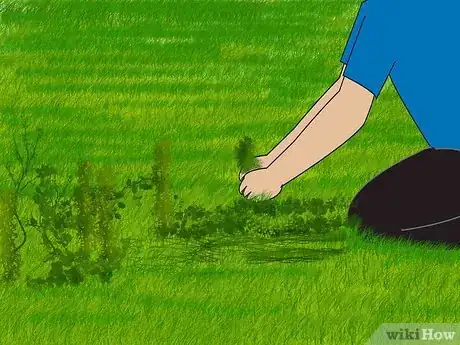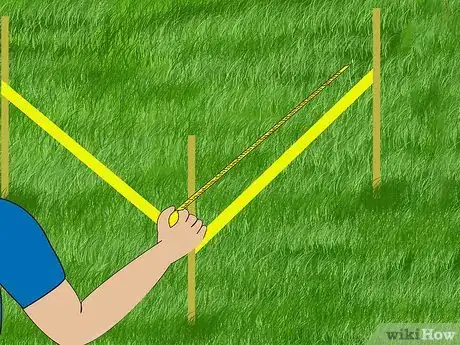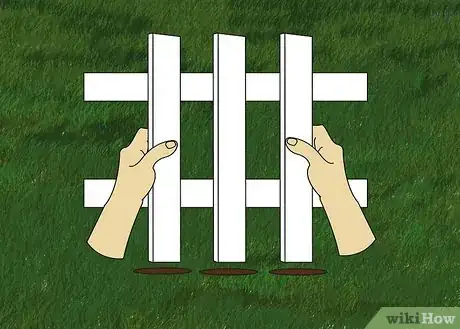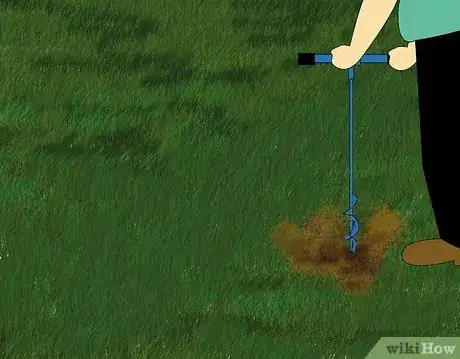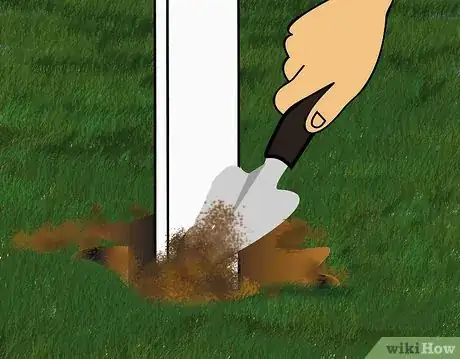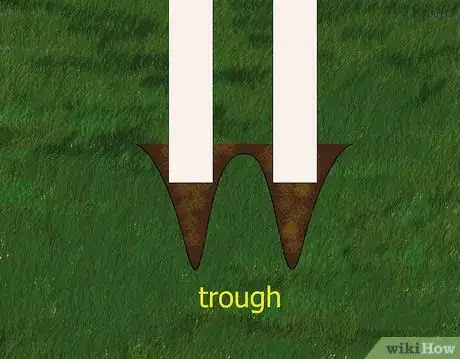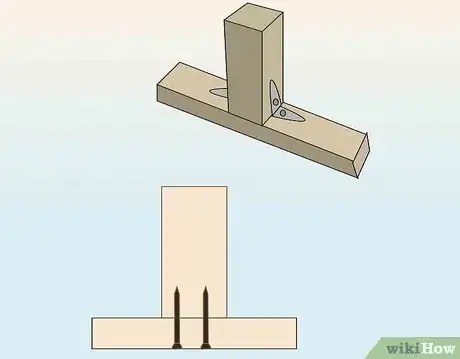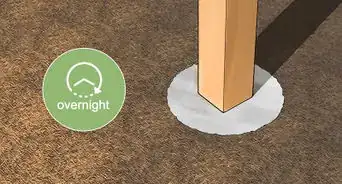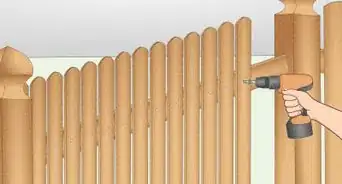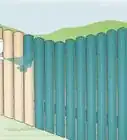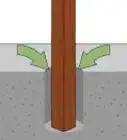This article was co-authored by Anthony "TC" Williams. Anthony "TC" Williams is a Professional Landscaper in Idaho. He is the President and Founder of Aqua Conservation Landscape & Irrigation, an Idaho Registered Landscape Business Entity. With over 21 years of landscaping experience, TC has worked on projects such as the Idaho Botanical Garden in Boise, Idaho. He is a Idaho Registered Contractor and a previously Licensed Irrigator in the State of Texas.
This article has been viewed 176,532 times.
Vinyl fencing comes in many styles and colors. It is a maintenance-free option that does not weather like wood fencing does. To install vinyl fencing, you need only attach pre-made fence sections to posts. Vinyl expands in hot temperatures and contracts in cold temperatures, so avoid installing your fence on extremely hot or cold days or your fence may warp and break.
Steps
Preparing the Project
-
1Prepare the ground for the fence. It's important to clear and smooth the area in which the vinyl fence will be installed to make the process as easy as possible. Remove any bushes, plants, trees or stationary objects that are in the way of your planned fence.
- Call the local utility diggers hotline to have all underground lines marked before you do any digging. In the United States or Canada, dial 811 or check with your local utility company. Many regions have their own digger's hotline numbers.
-
2Measure the area. Depending on the size and shape of your yard, or the area you want to fence off, you may want to go right along the property line, or measure other configurations and shapes. Whatever the case, you need to find out how much fencing you'll need to buy by measuring the desired area. Take these measurements to the home improvement store to buy supplies.[1]
- You can place stakes at the corners of your fence's perimeter and use them to rope the area off before the project begins, or you can spray paint the fence's perimeter.
Advertisement -
3Purchase the vinyl fencing and posts for the area. You can purchase vinyl fencing in lengths that range from 2 to 8 feet (0.6 to 2.4 m). These lengths you place between vinyl fence posts. If you are fencing a very large area, purchase larger sections so you can bury fewer fence posts.[2]
- Your material should be about one inch (2.5 cm) thick, four inches (10 cm) wide, and four to six feet (1.2 - 1.8 m) long. You will also need two 12 in (30 cm) wooden stakes and four screws for temporary bracing.
- Make sure you also get enough concrete for each post.
- If you need an entry point along the fence, it's also important to purchase a vinyl gate kit that fits with the fencing you choose.
-
4Mark each post location. After purchasing enough posts, fence lengths, and the gate kits necessary to make your fence, mark the post positions and the lengths between the desired posts to ensure your vinyl fence section and hardware will fit. You can't trim vinyl fencing sections, so you must be certain about your measurements.[3]
-
5Lay out the fencing sections. Between each place where you plan to dig a hole, it's a good idea to set everything up to make the installation process easier. Make sure your posts are in the right location before digging your holes.[4]
Installing the Fence
-
1Dig holes for your fence posts. Use either a power auger or a hand post-hole digger to dig holes that are 10 inches (25.4 cm) in diameter. Post holes should be deep enough to hold 1/3 the length of your post, plus 6 more inches for a gravel base.
- If you don't have an auger or digger, you can rent a power auger at a home improvement store, or you can dig them with a shovel, though it'll take a lot longer.
-
2Place the fence posts one at a time. Once you've dug the holes for the posts, the next step is to install each post securely before connecting them with the vinyl sections. Always defer to the manufacturer's instructions for installation, but generally its recommended to install posts secured with gravel and concrete.
- Insert a 2 foot (61 cm) long 4" x 4" or 5" x 5" and use 1.5 in (3.8-4 cm) screws on at least two sides to secure the post to wood. Place the post into hole on gravel base and then pour concrete into hole and evenly around entire post. Stop six inches (15 cm) below ground level to add soil for grass when concrete is cured.
- Check to make sure the pole is plumb using a level, and move on to the next post hole. Continue installing all the posts and return to the beginning and make sure it's seated level again.
-
3Slope the concrete. Use a trough to scrape any excess concrete away from the posts so that the concrete slopes down away from the pole. This prevents water from pooling around the pole. Let the concrete dry completely.[5]
-
4Install the vinyl fence sections between each post. Generally, vinyl fence sections snap right into place. Follow the specific manufacturer's directions regarding vinyl fence sections, as some may slide halfway into the post. Attach the rails to the ends of each section with screws, if necessary, and then secure the rails to the posts in the ground.[6]
- Pre-drilling a pilot hole before installing your rail screws can be helpful and may be necessary.
-
5Attach the vinyl post tops with the hardware provided. Again, defer to the manufacturer's instructions. Generally, most vinyl fence kits will come with decorative toppers for the posts that you can snap on.[7]
Community Q&A
-
QuestionDo I have to let the posts sit for awhile after I set them with concrete, before I put the fence together?
 Community AnswerIt is best practice to brace each post plumb (level) temporarily and at least 24 hours for concrete to fully harden.
Community AnswerIt is best practice to brace each post plumb (level) temporarily and at least 24 hours for concrete to fully harden. -
QuestionIs concrete necessary for installing a post?
 DonaganTop AnswererNot strictly necessary, but strongly recommended.
DonaganTop AnswererNot strictly necessary, but strongly recommended. -
QuestionCan vinyl fencing be installed with existing wood posts?
 Community AnswerNot recommended, as the wooden posts can rot and leave the vinyl posts without support.
Community AnswerNot recommended, as the wooden posts can rot and leave the vinyl posts without support.
Things You'll Need
- Tape measure
- Spray paint
- Auger or post-hole digger
- Quick-set cement
- Gravel
- Rubber mallet
- Screwdriver
- Level
- Bracing lumber
- Wooden stakes
- Screws
- Drill
- String line
- Shovel
References
- ↑ http://roomfortuesday.com/how-to-install-a-vinyl-privacy-fence/
- ↑ http://www.lowes.com/cd_Install+a+Vinyl+Fence_338022695_
- ↑ https://www.familyhandyman.com/garden-structures/fences/installing-a-vinyl-fence/
- ↑ https://www.thisoldhouse.com/how-to/how-to-install-vinyl-fence
- ↑ http://roomfortuesday.com/how-to-install-a-vinyl-privacy-fence/
- ↑ https://www.certainteed.com/resources/FRD_CertainTeed_Selects_Installation_Instructions_40-70-749.pdf
- ↑ https://www.certainteed.com/resources/FRD_CertainTeed_Selects_Installation_Instructions_40-70-749.pdf
About This Article
To install a vinyl fence, start by using a power auger or a post-hole digger to dig the holes for your fence posts. Make sure that the holes are 10 inches in diameter and deep enough to hold ⅓ the length of your post, plus 6 inches for a layer of gravel. Next, insert the posts into the hole 1 at a time, then pour concrete into the hole. Afterwards, slope the concrete by scraping the excess away from the posts with a trough to prevent water from pooling around the post. Then, install the vinyl sections between each post and attach the post tops. To learn more, including how to prepare the ground for the fence, scroll down.
